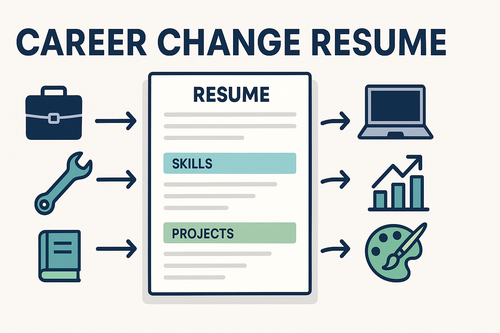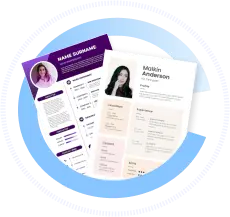Career Change Resume Format (Combination Template)
A career change resume using a combination format helps professionals smoothly transition to new fields by emphasizing transferable skills and relevant projects rather than chronological job history. In 2025, this format paired with ATS optimization can mitigate gaps and showcase your potential value to recruiters.
| Key Benefits of Combination Format |
|---|
| Highlights skills & achievements upfront |
| De-emphasizes unrelated or outdated job history |
| Bridges experience and new career goals |
| ATS-friendly structure with clear, scannable layout |
The Challenge (Recruiter Perspective)
Recruiters reviewing career change applicants often face challenges such as:
- Gaps or unrelated roles causing doubts
- Unclear connection between past roles and new field
- Difficulty finding relevant keywords for ATS scanning
A clearly structured resume that prioritizes skills and relevant experience eases this evaluation.
Choose the Right Format to De-Emphasize Gaps
- The combination resume places a Skills/Highlights section at the top, followed by a brief chronological work history.
- Use targeted headings like “Relevant Skills,” “Projects,” or “Volunteer Experience” before “Professional Experience.”
- Keep formatting clean, simple, and ATS-compatible—avoid graphics or complex layouts.
Reframe Experience (Skills, Projects, Volunteering)
- Identify and highlight transferable skills applicable to your new career.
- Showcase projects demonstrating competence in the new field.
- Include volunteering, freelance work, or certifications that support this transition.
- Briefly summarize unrelated jobs focusing on applicable soft skills.
Language Examples You Can Adapt
- Instead of “Managed sales teams,” say “Led cross-functional teams fostering collaboration and goal achievement.”
- Replace “Handled customer complaints” with “Developed conflict resolution skills improving client satisfaction.”
- Use action verbs highlighting adaptability, learning, and leadership.
How to Explain Gaps in Applications
- Be honest but brief. Use cover letters or interviews to provide context.
- Highlight productive activities during gaps such as courses, certifications, or volunteering.
- Avoid over-explaining or defensive language on your resume.
ATS Considerations
- Use keywords from job descriptions for your new industry and role.
- Maintain standard fonts and simple formatting.
- Avoid images, headers/footers, and unusual section titles that ATS may misread.
- Use plain bullet points to list skills and achievements.
Templates & Checklist
| Career Change Resume Checklist |
|---|
| Skills/Highlights section tailored to new role |
| Relevant projects and volunteering listed upfront |
| Concise chronological job history with transferable focus |
| ATS-friendly formatting and keyword usage |
| Clear, concise language emphasizing adaptability |
Copy-Ready Example (Combination Format)
Skills & Highlights
- Project management: Led 3 cross-functional teams in delivering projects on time and under budget.
- Customer relations: Developed strong communication and conflict resolution skills.
- Technical proficiency: Proficient in Microsoft Office, Salesforce, and data analysis tools.
Projects
- Volunteer Website Redesign: Collaborated with a team to redesign a non-profit website, improving user engagement by 50%.
Professional Experience
Sales Associate | RetailCorp | 2018–2024
- Managed daily customer interactions, building rapport and ensuring satisfaction.
- Trained new staff, honing leadership and training abilities.
FAQ
Q: Is the combination format best for all career changers?
A: It’s ideal for those with transferable skills needing to de-emphasize unrelated experience.
Q: How long should a career change resume be?
A: One to two pages, focused on relevance and clarity.
Q: Should I address career gaps on my resume?
A: Briefly mention productive activities; save detailed explanations for cover letters or interviews.
Q: Can I include freelance or volunteer work?
A: Yes, especially when relevant to your new career path.


